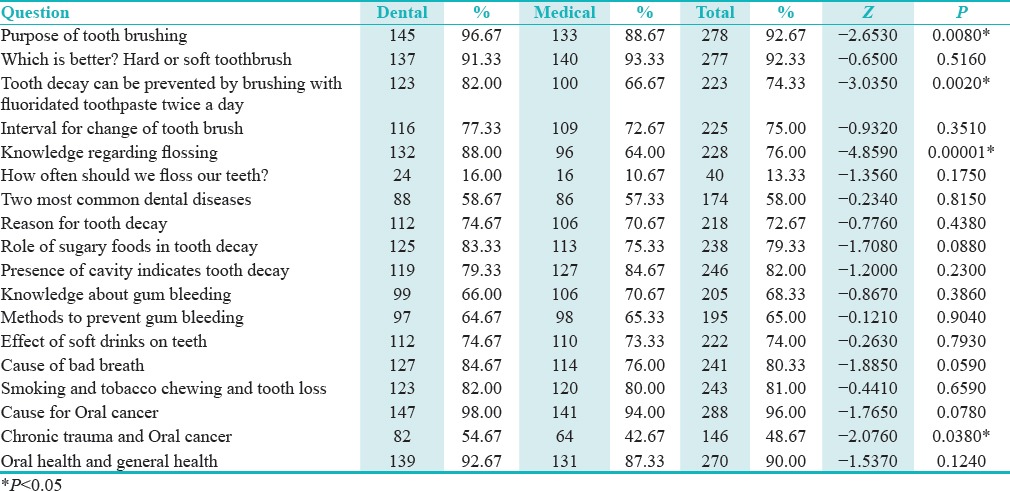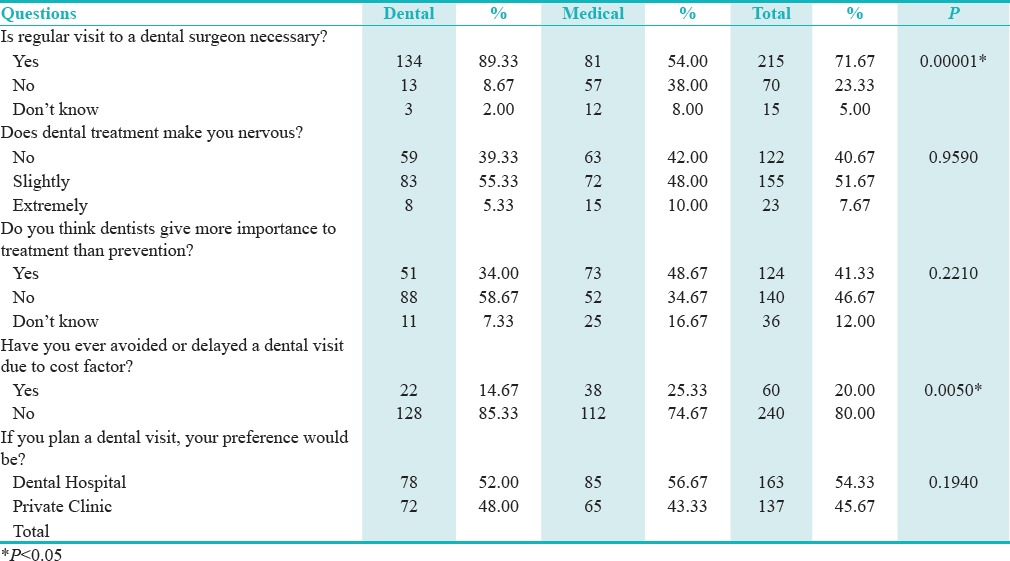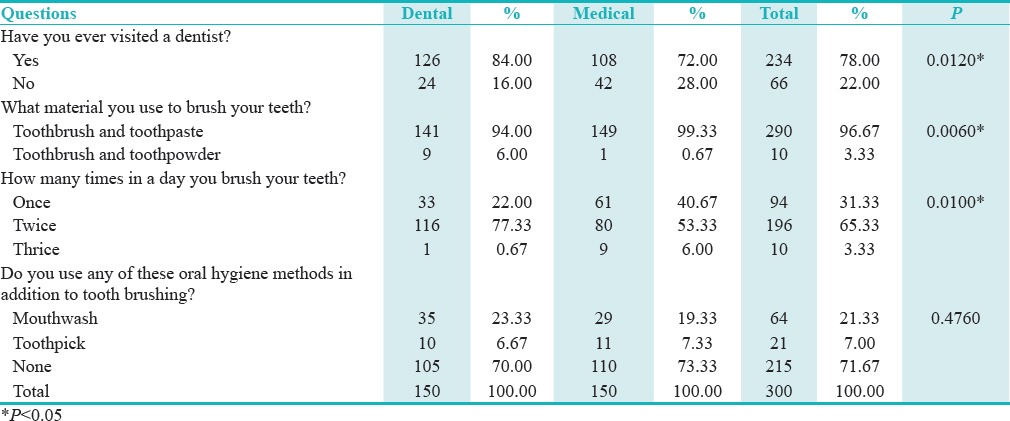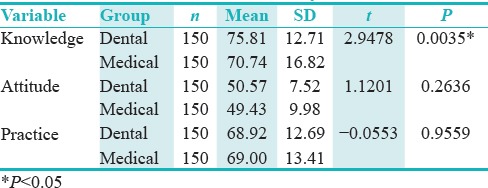Abstract
Objectives:
To compare oral health knowledge, attitude, and practices among dental and medical students in a Health care centre at Bhubaneswar, Odisha, India.
Materials and Methods:
One hundred and fifty BDS and MBBS students each from Kalinga Institute of Dental Sciences and Kalinga Institute of Medical Sciences of KIIT University, Bhubaneswar respectively, were invited to participate in this survey using a self-administered structured questionnaire in English comprising 27 questions, which was designed to evaluate the oral health knowledge, attitude, and practices. The obtained data was analyzed using the Statistical Package for the Social Sciences version 20 software.
Results:
On comparison of the scores of knowledge, attitude, and practice, the mean knowledge score was significantly higher among dental students than medical students. The study also showed that female students (both dental and medical) had better oral health knowledge and showed better oral health practices than male students. Karl Pearson's correlation coefficient test showed that, although dental students had better knowledge and attitude towards oral health, there was a lack of adequate practice among them.
Conclusion:
Further emphasis on oral health is necessary in undergraduate training to improve oral health knowledge, attitude, and practice among dental and medical students as they will act as role models for oral health education among individuals and community at large.
KEYWORDS: Attitude, dental students, knowledge, medical students, practice
INTRODUCTION
Oral health is an essential component of general health and overall well-being of an individual. Oral cavity and its surrounding structures that are free of any diseases is indicative of good oral health. This not only makes a person look and feel good, it is equally relevant in maintaining oral functions.[1,2] Because professional (dental) students specialize in preventive information and health promotion, it is important that their own oral health knowledge, attitude, and practice are adequate.[3] Moreover, medical students are far more likely to encounter underserved and vulnerable populations than dental students.[4] They should have optimal knowledge regarding oral health so that they can provide the required oral health education and guide or refer to a dental surgeon as and when required. Thus, oral health care needs to be addressed by the combined efforts of dental and medical professionals and should be integrated into comprehensive health-promoting strategies and practices.[5,6] Because today's students will provide health services in the future and will be responsible for public oral health education, it is important to study their oral health knowledge, attitude, and practice.
The present study aims at comparison of oral health knowledge, attitude, and practices among dental and medical students of KIIT University in Bhubaneswar, Odisha, India.
MATERIALS AND METHODS
BDS and MBBS students were invited from Kalinga Institute of Dental Sciences and Kalinga Institute of Medical Sciences, Bhubaneswar, respectively, to participate in this survey using a self-administered structured questionnaire written in English and validated through a pilot study during the academic session 2016–2017. It was voluntary participation, and informed consent was obtained from those who participated in the study. All the students were explained regarding the nature and purpose of the study. Permission to conduct the survey was obtained from the Institute's Ethics Committee.
The questionnaire consisted of 27 questions designed to evaluate the oral health knowledge, attitude towards the dental surgeon and dental treatment, and practices in relation to oral health among the BDS and MBBS students. The questionnaire was organized into 4 parts: The first part elicited information on the demographic attributes of students including age, gender, and year of study.
The second part assessed the participant's oral health knowledge and included 18 questions on purpose of tooth brushing, type of tooth brush, time interval for change of tooth brush, flossing, knowledge about the cause and prevention of tooth decay, common dental diseases including gum disease, effect of soft drinks on teeth, bad breath, role of tobacco, oral cancer, and importance of oral health on general health.
The third part was used to elicit their attitude towards the dental surgeon and dental treatment and comprised 5 questions regarding regular visit to a dental surgeon, attitude towards dental care, cost associated with treatment, and preferred place of visit in terms of dental clinic or dental hospital.
The last part assessed the practices in relation to oral health by using 4 questions regarding their visit to dental surgeon, materials used and frequency of brushing, and oral hygiene aids used in addition to tooth brushing.
The students were asked to respond to each item according to the response provided in the questionnaire. Responses included multiple-choice questions in which the students were instructed to choose only one appropriate response from a provided list of options. One hundred and fifty completely filled questionnaires from dental students and 150 from medical students were collected and analyzed.
STATISTICAL ANALYSIS
The obtained data were analyzed using the Statistical Package for the Social Sciences (SPSS) software for windows version 20.0 (IBM SPSS-Chicago, IL:SPSS Inc.). The Mann–Whitney U test was used to compare the knowledge, attitude, and practice related to oral health in both groups. The t-test was used to compare the mean percentage scores for knowledge, attitude, and practices among dental and medical students. Correlation between knowledge, attitude, and practice were examined by Karl Pearson's correlation coefficient method. A P value of 0.05 was used as a cut-off level for statistical significance.
RESULTS
One hundred and fifty completely filled questionnaires from dental students (mean age: 20.19 ± 1.46) and 150 from medical students (mean age: 21.00 ± 2.05) were collected. Table 1 shows the age and gender distribution of the participants.
Table 1.
Age and gender distribution of the participants

A total of 92.67% of the students (96.67% dental and 88.67% medical) knew that the purpose of tooth brushing was to prevent tooth decay and gum disease, and the difference was statistically significant (P =0.0080). Eighty-two percent of the dental students believed brushing with fluoridated toothpaste twice a day prevents tooth decay whereas only 66.67% of the medical students were aware about the fact; the values were statistically significant (P =0.0020). In terms of knowledge regarding flossing, 88% dental and 64% medical students had heard about flossing, and the difference was highly significant (P =0.00001). Awareness regarding chronic trauma increases the chance for oral cancer showed statistically significant difference (P =0.0380) among dental (54.67%) and medical (42.67%) students. Almost all dental and medical students were aware that a soft toothbrush is preferable over hard bristles, smoking and/or tobacco chewing can cause oral cancer, and general health is related to oral health. More than 50% of the respondents knew about the interval for changing tooth brush, tooth decay and gum disease to be the most common dental diseases, improper brushing and consumption of sugary foods and soft drinks as the cause of tooth decay, presence of cavity as an indication of tooth decay, gum bleeding and how to prevent it, cause of bad breath, and smoking and tobacco chewing increases the chance for tooth loss. Table 2 shows the comparison of dental and medical students in each question of knowledge (numbers are only correct answers) by Mann–Whitney U test.
Table 2.
Comparison of dental and medical students in each question of knowledge (numbers are only correct answers) by Mann-Whitney U test

A total of 89.33% of the dental students believed that regular visit to dental surgeon is necessary whereas only 54% medical students agreed on the fact; the difference was highly significant (P =0.00001). Almost half (51.67%) of the students were slightly nervous regarding dental treatment. Medical students felt that dental surgeons give more importance to treatment rather than prevention in contrast to dental students who believed that both are given equal importance. Eighty percent of the students (85.33% dental and 74.67% medical) said they did not avoid or delay a dental visit due to cost, and the results were significant (P =0.0050). Dental hospital and private clinic were almost equally voted as the preferred place of visit for treatment. Table 3 shows the comparison of dental and medical students in terms of attitude.
Table 3.
Comparison of dental and medical students in terms of attitude towards the dental surgeon and dental treatment

A total of 84% dental and 72% medical students had visited a dentist at least once in their lifetime, and the difference was statistically significant (P =0.0120). Almost 97% of the students (94% dental and 99.33% medical) used toothbrush and tooth paste to clean their teeth, and the value was statistically significant (P =0.0060). There was significant difference in tooth brushing frequency between dental and medical students. More than 70% of students did not use any other oral hygiene methods in addition to tooth brushing. Comparison of dental and medical students in terms of practice of oral health is presented in Table 4.
Table 4.
Comparison of dental and medical students in terms of practice of oral health

Significant difference only in terms of knowledge was seen when mean percentage scores were compared between dental and medical students [Table 5].
Table 5.
Comparison of dental and medical students mean percentage scores for knowledge, attitude, and behavior of students by t-test

The study showed that female students (both dental and medical) had better oral health knowledge and showed better oral health practice than male students, and the difference was statistically significant [Table 6].
Table 6.
Comparison of male and female dental and medical student’s mean percentage scores for knowledge, attitude, and behavior by t-test

Correlation between knowledge, attitude, and practice was examined by Karl Pearson's correlation coefficient method. A positive linear relationship was found between attitude and knowledge, practice, and knowledge whereas a negative linear relationship was found between practice and attitude of dental students. Among medical students, a positive linear relationship was found between attitude and knowledge, practice and knowledge, and practice and attitude [Table 7].
Table 7.
Correlation between knowledge, attitude, and practice by Karl Pearson’s correlation coefficient method

DISCUSSION
Health professionals play a pivotal role in providing knowledge regarding oral health and its significance among general public. Dental and medical students should possess high level of awareness of self oral health care so that this attitude can be instilled among patients and community at large.
The methodological strength of the present study was that it was the first formal assessment of oral health knowledge, attitude, and practices among dental and medical students conducted in Bhubaneswar city with an adequate sample size. There were no controversies raised by the study.
In the present study, the scores of knowledge, attitude, and practice of dental students was compared with that of the medical students, and it was noted that the mean knowledge score was significantly higher among dental students than medical students, which is in agreement with the results of similar study by Rong WS et al., Al-Batayneh et al., Saran et al., and Al Kawas et al.[7,8,9,10]
A total of 77.33% of the dental students brushed twice a day compared to 53.33% of the medical students, hence indicating better oral hygiene measures adopted by dental students. Similar result was reported by Al Omari et al. and Peker et al.[11,12] Neeraja et al. reported that 74% of the dental students brushed their teeth twice daily.[13] Based on a study by Ansari et al., 34% of health sciences students brushed twice daily and 45% once a day.[14] On the contrary, a higher percentage (65.33%) of both dental and medical students in our study brushed twice whereas a lower proportion (31.33%) brushed once daily. On the other hand, Baseer et al. reported that 77.9% of the health professionals brushed their teeth once in the morning.[6] Result of another study by Benjamin et al. conducted in the University of Nairobi showed that 27.5% of the dental and 39% of the medical students brushed twice daily, and the values were much lower than those reported in our study.[15]
Eighty-two percent of our dental students felt that tooth decay can be prevented by brushing with fluoridated toothpaste, and this is almost compatible with the findings of the studies by Cebeci et al. who reported it to be 79% and Ahamed et al. who reported it to be 81% among clinical dental students.[16,17] According to our study, 96.67% students (141 dental and 149 medical) used toothbrush and toothpaste as cleaning aids. Similar results were reported by Baseer et al. in a KAP study among health professionals in Riyadh.[6]
Flossing of teeth is as much required as brushing for complete cleanliness of teeth. A total of 32.3 % of Turkish dental students flossed regularly while 16% of our dental students flossed.[12] This shows that students are not well educated regarding the benefits of flossing.
Only 79.33% of our study participants felt that there was a role of sugary foods in causing tooth decay, whereas Ansari et al. in his study found that it to be 93.8%; thus, showing higher level of awareness compared to our study participants.[14] On the other hand, both dental and medical students in our study were much more aware of the effect of soft drinks on teeth as compared to studies by Ansari et al.[14] Most of the dental (92.67%) and medical (87.33%) students considered oral health to be important in maintaining good general health, and this is compatible with the findings of the study by Usman et al. (dental 96%, and medical 80%).[3] On the other hand, 80% dental and 67% medical students in Kanpur city considered oral health to be a part of overall health.[18]
The question of knowledge regarding smoking and tobacco chewing as the cause of oral cancer showed much higher frequency of correct answers among both dental (98%) and medical (94%) students in our study, and this was consistent with the findings of Frola and Barrios.[19] On the other hand, Ahamed et al. reported that only 78% of the dental students were aware about the cause of oral cancer.[17]
In terms of visiting a dentist, 84% of dental students in our study had visited once in their lifetime in contrast to 30% and 32% reported by Peker et al. and Neeraja R et al. respectively.[12,13] This was significantly lower than that reported among Jordanian students (86%) as reported by Al Omari et al. Mani et al. reported that 92.4% of the dental students disagreed in terms of not worrying much about visiting a dentist, which was in accordance with our study.[11,20] Similarly, Al Kawas et al. reported only 8% of the dental students were not much worried about visiting a dentist as compared to 30% of the medical students who were.[10] On the contrary, Usman et al. reported 88.3% and Ansari et al. reported 60% of the medical, dental, and paramedical students to have visited a dentist at least once in their lifetime.[3,14]
A total of 89.33% of our dental students and 81% of medical students felt the necessity of regular visits to a dental surgeon. On the contrary, Al Kawas et al. reported that 46% of the medical students put off going to the dentist until they had toothache as compared to 20% of dental students.[10] Usman et al. reported that 75% of medical students, 86% of paramedical students, and 69% of dental students put off visiting a dentist till they encountered a dental problem.[3]
Our study showed female participants to be better than their male counterpart in terms of knowledge and practice. This was in accordance with several studies including Al Omari et al., Porat et al., Nanakorn et al., Kassak et al., Halboub et al. and Rashid et al., and contrary to the studies reported by Ahamed et al., Sharda and Shetty, and Khami et al.[11,17,21,22,23,24,25,26,27] Ostberg and Fukai reported female dental students to have better oral health attitudes than males.[28,29] This has been attributed to the positive self care attitudes for internal psychological reasons to improve their appearance and self esteem.[10] On the contrary, Tseveenjan et al. reported no differences between male and female Mongolian dental studies in terms of practice.[30]
Several studies have shown oral health knowledge and attitude to be high among the dental students because it forms a significant part of their curriculum, and hence, positively influences their attitude and behavior.[9,10,31] Because good oral health is essential for good general health, medical education should include oral health as an integral component of their curriculum. Moreover, our study showed that though dental students had better knowledge and attitude towards oral health, rightly practicing it remains a concern. On the contrary medical students showed better practice of oral health and hygiene.
The only limitation of this study is that, even though the confidentiality is maintained, scores depends on self-reported data, which may be over- or underreported due to social desirability.
Several areas such as knowledge regarding association of chronic trauma and oral cancer, reasons for a delayed dental visit including cost factor, and use of other oral hygiene methods in addition to tooth brushing still remain unexplored, which warrant the need for conducting more such studies. Moreover, the present study is limited to a questionnaire. To study the effect of oral health education among dental and medical students, cross-sectional and longitudinal comparisons would be more helpful. Clinical examination of the students to substantiate the answers to the questionnaire would be more desirable.
CONCLUSION
In the present study, we found that oral health knowledge of dental students were better compared to medical students as oral health is a significant component of the dental curriculum. Female students had better oral health knowledge and took better care of their teeth than male students. Further emphasis on oral health is necessary in undergraduate training to improve oral health knowledge, attitude, and practice among the students. These students who are the future providers of dental and medical care will act as role models for oral health education among individuals and community at large.
FINANCIAL SUPPORT AND SPONSORSHIP
Nil.
CONFLICTS OF INTEREST
There are no conflicts of interest.
REFERENCES
- 1.Abdollahi M, Radfar M. A review of drug-induced oral reactions. J Contemp Dent Pract. 2003;4:10–31. [PubMed] [Google Scholar]
- 2.Puy CL. The role of saliva in maintaining oral health and as an aid to diagnosis. Med Oral Patol Oral Cir Bucal. 2006;11:E449–55. [PubMed] [Google Scholar]
- 3.Usman S, Bhat SS, Sargod SS. Oral Health Knowledge and Behavior of Clinical Medical, Dental and Paramedical studentsin Mangalore. J Oral Health Comm Dent. 2007;1:46–8. [Google Scholar]
- 4.Kaur S, Kaur B, Ahluwalia SS. Oral Health Knowledge, Attitude and Practices amongst Health Professionals in Ludhiana, India. Dentistry. 2015;5:315. [Google Scholar]
- 5.A-Rabiei S, Mohebbi SZ, Patja K, Virtanen JI. Physicians' knowledge of and adherence to improving oral health. BMC Public Health. 2012;12:855. doi: 10.1186/1471-2458-12-855. [DOI] [PMC free article] [PubMed] [Google Scholar]
- 6.Baseer MA, Alenazy MS, AlAsqah M, AlGabbani M, Mehkari A. Oral health Knowledge, attitude and practices among health professionals in King Fahad Medical City, Riyadh. Dent Res J. 2012;9:386–92. [PMC free article] [PubMed] [Google Scholar]
- 7.Rong WS, Wang WJ, Yip HK. Attitudes of dental and medical students in their first and final years of undergraduate study to oral health behaviour. Eur J Dent Educ. 2006;10:178–84. doi: 10.1111/j.1600-0579.2006.00415.x. [DOI] [PubMed] [Google Scholar]
- 8.Al-Batayneh, Owais OB, Khader AI. Oral health knowledge and practices among diverse university students with access to free dental care: A cross sectional study. Open J Stomatol. 2014;4:135–42. [Google Scholar]
- 9.Saran R, Kumar S. Oral health knowledge, attitude and behaviour of medical and dental students. Int J Sci Res. 2016;5:359–60. [Google Scholar]
- 10.Al Kawas S, Fakhruddin KS, Ur Rehman B. A comparative study of oral health attitudes and behaviour between dental and medical students; the impact of dental education in United Arab Emirates. J Int Dent Med Res. 2009;2:6–10. [Google Scholar]
- 11.Al-Omari QD, Al-Hadi Hamasha A. Gender specific oral health attitudes and behaviour among Dental students in Jordan. J Contemp Dent Pract. 2005;6:107–14. [PubMed] [Google Scholar]
- 12.Peker I, Alkurt MT. Oral health attitudes and behaviour among a group of Turkish Dental students. Eur J Dent. 2009;3:24–31. [PMC free article] [PubMed] [Google Scholar]
- 13.Neeraja R, Kayalvizhi G, Sangeetha P. Oral health attitudes and behaviour among a group of dental students in Bangalore, India. Eur J Dent. 2011;5:163–7. [PMC free article] [PubMed] [Google Scholar]
- 14.Al Ansari J, Honkala E, Honkala S. Oral health knowledge and behaviour among male health sciences college students in Kuwait. BMC Oral Health. 2003;3:2. doi: 10.1186/1472-6831-3-2. [DOI] [PMC free article] [PubMed] [Google Scholar]
- 15.Benjamin SN, Gathece LW, Wagaiyu EG. Knowledge, Attitude and Use of Mouthwash among Dental and Medical Students of the University of Nairobi. Int J Dent Oral Health. 2016;2 [Google Scholar]
- 16.Ozyemisci-Cebeci N, Unver S, Nemli SK. A comparative study of oral health attitudes and behaviours in dental students. J Dent App. 2014;1:3–7. [Google Scholar]
- 17.Ahamed S, Moyin S, Punathil S, Patil NA, Kale VT, Pawar G. Evaluation of the oral health knowledge, attitude and behaviour of preclinical and clinical dental students. J Int Oral Health. 2015;7:65–70. [PMC free article] [PubMed] [Google Scholar]
- 18.Pradhan D, Kumar J, Shavi G, Pruthi N, Gupta G, Singh D. Evaluating the Oral hygiene K.A.P. among Dental and Medical students in Kanpur City. Natl J Integr Res Med. 2016;7:73–6. [Google Scholar]
- 19.Frola MI, Barrios RJ. Knowledge and Attitudes About Oral Cancer Among Dental Students After Bologna Plan Implementation. Canc Educ. 2016 doi: 10.1007/s13187-016-0990-9. [Epub ahead of print] [DOI] [PubMed] [Google Scholar]
- 20.Mani PM, Swamy RM, Manjunath GN, Venkatesh G, Venkateshappa C, Kumar N. Attitude of dental students towards their oral health care. Res J Pharm Biol Chem Sci. 2013;4:755–9. [Google Scholar]
- 21.Porat D, Kawamura M, Eli I. Effect of professional training on dental health attitudes of Israeli dental students. Refuat Hapeh Vehashinayim. 2001;18:51–6. [PubMed] [Google Scholar]
- 22.Nanakorn S, Osaka R, Chusilp K. Gender differences in health related practices among university students in northeast Thailand. Asia Pac J Public Health. 1991;11:5–10. doi: 10.1177/101053959901100103. [DOI] [PubMed] [Google Scholar]
- 23.Kassak KM, Dagher R, Doughan B. Oral health and lifestyle correlates among new undergraduate university students in Lebanon. J Am Coll Health. 2001;50:15–20. doi: 10.1080/07448480109595706. [DOI] [PubMed] [Google Scholar]
- 24.Sharda AJ, Shetty S. A comparative study of oral health knowledge, attitude and behaviour of first and final year dental students of Udaipur city, Rajasthan. J Oral Health Comm Dent. 2008;2:46–54. doi: 10.1111/j.1601-5037.2008.00308.x. [DOI] [PubMed] [Google Scholar]
- 25.Khami MR, Viratanen JI, Jafarian M, Murtomaa H. Prevention oriented practice of Iranian senior dental students. Eur J Dent Educ. 2007;11:48–53. doi: 10.1111/j.1600-0579.2007.00436.x. [DOI] [PubMed] [Google Scholar]
- 26.Halboub ES, Al-Maweri SA, Al-Jamaei AA, Al-wesabi MA, Shamala A, Al-kamel A, et al. Self-Reported Oral Health Attitudes and Behavior of Dental and Medical students, Yemen. Glob J Health Sci. 2016;8:143–50. doi: 10.5539/gjhs.v8n10p143. [DOI] [PubMed] [Google Scholar]
- 27.Rashid MS, Ali I, Khan ZR, Bashir S, Haider SM, Hafeez N, et al. Attitude Towards Own Oral Health and Hygiene: A Survey of Medical and Dental Students of Karachi, Pakistan. J Pak Dent Assoc. 2016;25:54–9. [Google Scholar]
- 28.Ostberg AL, Halling A, Lindblad U. Gender differences in knowledge, attitude, behaviour and percieved oral health among adolescents. Acta Odontol Scand. 1999;57:231–6. doi: 10.1080/000163599428832. [DOI] [PubMed] [Google Scholar]
- 29.Fukai K, Takesu Y, Maki Y. Gender differences in oral health behaviour and general health habits in an adult population. Bull Tokyo Dent Coll. 1999;40:187–93. doi: 10.2209/tdcpublication.40.187. [DOI] [PubMed] [Google Scholar]
- 30.Tseveenjav B, Vehkalahti M, Murtomaa H. Preventive practice of Mongolian dental students. Eur J Dent Educ. 2002;6:74–8. doi: 10.1034/j.1600-0579.2002.60206.x. [DOI] [PubMed] [Google Scholar]
- 31.Nirmala SVSG, Quadhar MA, Veluru S, Tharay N, Kolli NKR. Oral health behaviour among medical, dental and paramedical students – a cross sectional study. Carib J Sci Tech. 2015;3:774–80. [Google Scholar]


